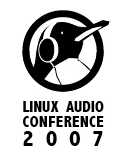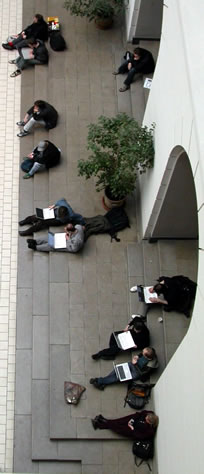[REVIEW] Linux Audio Conference 2007
Berlin, 22–25 March 2007

SWR2 JetztMusik
Original transcript used for a broadcast on southern German radio SWR2 JetztMusik-Magazin on 26 March 2007. Production: Lydia Jeschke. Published here with the kind permission of the author.
[ Played: André Bartetzki — Reale Existenz! (2007) ]
Folkmar Hein: Ich bin also nicht einer derjenigen, der nun sagt, man hätte jetzt das Ziel erreicht, was unsere Vorväter ja schon in den 50er Jahren haben wollten. Sondern es ist eine andere Methode, mit der noch niemals richtig experimentiert werden konnte ….
[I am not one who would now say that we have achieved the goals that the pioneers in the 50s wanted. Rather it is another method, and one with which much experimentation could be done.]
After a five-year residency in the ZKM in Karlsruhe, the 5th International Linux Audio Conference took place this weekend in Berlin. The host was the Communications Department of the Technical University (TU) Berlin, which has a 50-year tradition with electronic music through its Electronic Music Studio.
The Linux Audio Community is made up of institutions, programmers, sound engineers, composers and musicians who work with the Linux operating system. In regards to its use in multi-media projects, Linux has the not entirely unjustified reputation of being clearly inferior to concurrent operating systems such as Macintosh or Windows. Linux Audio seeks on the one hand to challenge this perspective through the bundling of development initiatives, and on the other, to convince the general public of the multitude of possibilities it is capable of offering today.

Already its open structure makes Linux a success, allowing composers and musicians to find and develop working methods for their projects and pieces that are independent of existing commercial programmes. Through seminars and workshops, such solutions were presented and discussed alongside scientific and technical research, accompanied this year by significantly more interesting musical propositions. Four concerts of electronic music, complemented by sound installations and Campus Radio and club events, the whole realised using Linux, were co-produced by concert presenters and institutions such as the DAAD artist programme, MärzMusik festival and Tesla.
With a massive speaker system (completed just in time for the events), the Electronic Studio of the TU presented what was the highpoint of the conference, an impressive display of the possibilities offered by open source programmes and research. In a continuous ring around the walls of the H-104 Auditorium of the TU’s main building, 2730 loudspeakers were installed, which are sent over 840 channels. The underlying acoustic concept of this system stems from Wave Field Synthesis, which in contrast to typical surround systems allows for the spatial positioning of sound independent of the position of the listener. Folkmar Hein, Director of the Studios:
Also es geht im Grunde genommen ein bisschen auch um die Situation wie sie in der Natur ist, dass ich eben meinen Kopf beliebig bewegen kann und die Klangquellen, die bewegen sich natürlich nicht mit meinem Kopf mit, so, das ist ja das Problem, so und das hat man in der Wellenfeldsynthese genau erreicht. Sie erzeugen dort ja die natürlichen Wellen und deshalb ist ja vollkommen wurst, wo sie stehen: Der Eindruck ist der gleiche.
[Basically, it is a situation which is a little like the situation in nature, where I can move and position my head as I wish, and the sound waves adjust naturally with my movement; this is exactly the problem that WFS has resolved. Natural waves are produced and so it doesn’t matter where you are within the filed, the impression is the same.]
Research in the TU Studios on WFS goes back to 2001, when the Edgar-Varese Guest Professor Diemer de Vries (Holland) did experiments with a line of 24 loudspeakers in the studio. As part of her Doctoral grant, engineer Marije Baalman (also from Holland) has developed an open source software based in Linux, which she has compiled with the help of a team which has been adapted to the new system.
The Studio’s Wave Field Synthesis system is unique in the world, especially looking back on the size of the room and the number of speakers. And it is an amazing experience to be able to move around sounds positioned in the room, which at the moment is only possible in more or less empty halls and even then not in all positions. The system will be used in the coming years as an acoustic research lab to perform practical tests on theoretical models. Nonetheless, as with the trasdition of the TU Studios, this project does not have purely scientific intentions, the WFS system should be understood as a musical instrument:
Folkmar Hein: Dann ist die Vorstellung eben die, dass man dieses Wellenfeldsynthese-System hat, um mal ausloten, ob es künstlerisch interessant ist und ob es einem gelingt, eben diese Erscheinungsformen des Klangs zu erzeugen, nämlich von Tiefe, bedeutet: ein Klang ist nah bei mir, es hat auch eine mittlere Distanz und es hat auch eine weite Distanz.
[The idea behind this Wave Field Synthesis system is to “sound out” whether it is artistically interesting and if it succeeds in producing the perception that a sound can sit in different proximities to the listener, that it can be near me, but can also have a medium distance as well as a broad distance.]
The first experiments with the system were conceived for the festival: four composers were invited to present works on the new system. We just heard excerpts from Andre Bartetzki’s Reale Existenz!, based on a lecture by the Austrian physicist Erwin Schrödinger, one of the pioneers of Quantum Physics. The work shows (for obvious reasons not evident over the radio) the superiority of the WFS system over common loudspeaker systems, which do not allow for sonic illustrations situated between the speaker and the listener. It shows as well that one must learn to work with this new instrument just as with any other instrument, and that it is not trivial to adapt experiences with other surround systems to the work with Wave Field Synthesis. The sound spatialisation in Bartetzki’s work in fact remained for the most par tin the traditional spatial areas behind the speakers and realistic movements through the room occurred only rarely.

Another proposition, comparable in its State-of-the-Art technological development, but with contrasting artistic ideas to the WFS system, was the Spanish group Recursive Dog Collective, whose work addresses the ideological aspects of Free Software, Free Hardware und Free Culture intimitely associated with Linux. Working in the areas of Hacker activism and home-made Generative Art, this trio build and programme their own electronic instruments. The rather discouraging proclamation made during the workshop, “We aren’t interested in making ‘good’ music but would rather show what you can throw together in the two hours before the performance,” proved to be quite an understatement in the Instituto Cervantes concert. Between two multi-channel works of a very high quality of craftsmanship (remaining however completely in the realm of electronic music clichés), the trio offered a Low-Tech performance with very convincing musical qualities. The listener participates in an essentially musical proceeding, from which he is normally excluded: the cautious, intense approximation of an instrument which, with any movement, can abruptly exceed its limits, become sonically unstable and explode.
The title of the improvisation Recursive Door refers to Aldous Huxley’s 1954 Essay “The Doors of Perception.” The author proposes that the Collective Memory of humanity is “hardwired” to our brains and that a protective mechanism hinders perceptions which lie beyond or hidden by this concept. Huxley would in the 1960s distance himself from his reflections that this filter function can be “short-circuited” through the use of drugs. The Recursive Dog Collective see their music — generatively-produced and performed on and controled by self-made instruments — as an artistic analogy to the “expanded consciousness” that Huxley described and analysed.
[ Played: Recursive Dog Collective — Recursive Door ]

Other Articles by the Author
See the author’s website.
Recursive Dog Collective
If the doors of perception were cleansed everything would appear to man as it is, infinite.
—William Blake
RecursiveDoor is an experimental sound experience based on Aldous Huxley’s book, The Doors of Perception, inspired by Blake’s words. Combining a free open source environment and open hardware “home-made” interfaces, the collective develops alternative physical and conceptual interfaces around the concept of Creative Commons. Their interests “dance” around electronic prototypes, generative sound and video, physical interfaces and sensor-controlled installation.
Related Links
LAC 2007 — 5th International Linux Audio Conference
Studio der TU (Technische Universität) Berlin
Marije Baalman’s WFS project
Andre Bartetzki
Linux Audio
Linux audio developers mailing list
Linux audio user mailing list
Social top